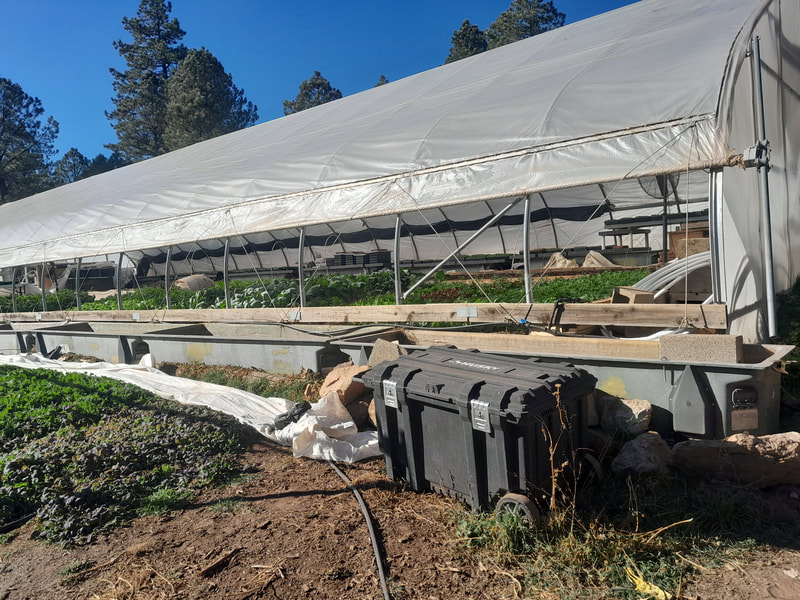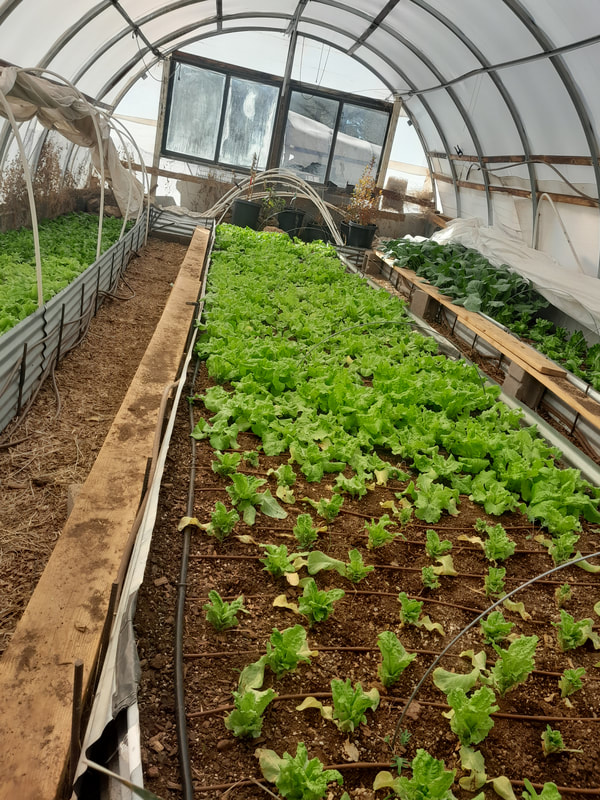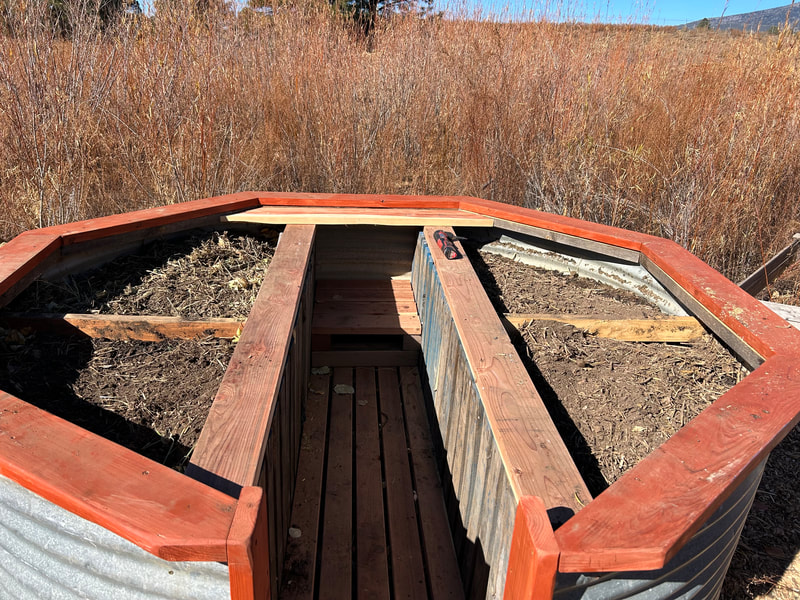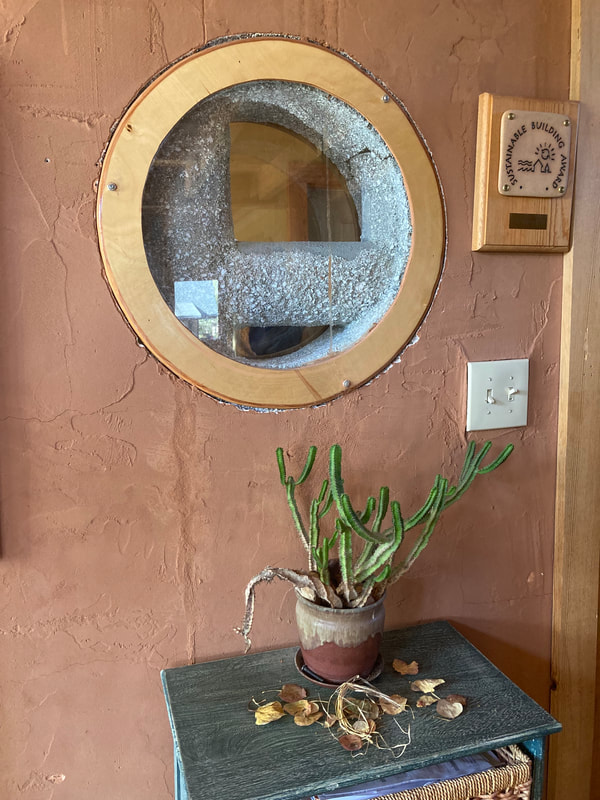Rosemary LoganCheckout the Spring 2020 section of NAU's two-semester Permaculture Design Course Blog! Archives
December 2023
Categories |
Back to Blog
Colton Garden: An Exploration of Soils11/30/2023 Emily Roll On November 15th, the permaculture class went to Colton Community Garden to experience a workshop on soils with Fritz. We worked on building up garden beds for a youth greenhouse in a geodome design, and laid down pathways in one of the larger greenhouses with red wigglers and compost to create a nutrient-rich soil at the base of the garden beds. We had access to many different types of organic materials to build up healthy soil and begin the process of nutrient cycling to prepare for growing next season. The knowledge gained from this trip was unmatched, and we were given many resources on soil and food growing that are shown below.
The importance of soil in food production is almost indescribable; soil is the home of nutrients and microorganisms that give our food the nutrients we humans need. Soil acts as an ecosystem, home to worms and microorganisms, nitrogen and carbon, that all come from the layering of organic material and water. As said previously, we were given access to various materials to build up our lasagna gardens as Fritz describes. We had compost from community drop off and the river trip waste that was high in nitrogen. We also had leaves to provide carbon into the system, large logs to add an element of hügelkultur, bigger pieces of dry straw, coffee grounds, and existing soil. All of these things layered together with water will decompose and become the home to microorganisms and mycelium that will work to decompose all the food scraps and larger materials into a mixture of nutrient exchanging. Another aspect of soil building that could be added, that we did not have access to on this visit, is charcoal or biochar. Adding charcoal to garden beds has been a somewhat tricky and recent subject to the world of permaculture and gardening. There is debate on the best time to add charcoal into beds, whether it is activated or inactivated, and the depth to which it should be buried in the soil. The benefits of activated charcoal are becoming clear; it creates areas of nutrient and water retention and microbe habitat, lightens dense soil to allow better root growth, and aerates to increase drainage. Charcoal can also be used in soil that has been damaged by chemicals or pesticides as it brings down acidity and neutralizes the chemicals. The best way to add charcoal to garden beds is simply to just start trying it; every soil system is a bit different and trial and error may be the best way to determine the real impacts of charcoal in especially at-home gardens. Soil is an inexhaustible resource in gardens, and in permaculture as a concept. Soil connects every aspect of the earth together, and gives us the resources we need to thrive. It needs to be taken care of just as it provides for us, and that is truly where permaculture comes into the picture. Perma-culturists believe pesticides are not necessary to having a healthy and protected ecosystem, nature does that on its own and celebrates diversity. Applying these principles to soil gives a head start to letting nature do what it will do in that micro-ecosystem. Encouraging microorganisms and even what we characterize as pests into the garden, letting them all interact will, in most cases, actually helps the soil thrive and in turn our food to thrive. As said earlier, trial and error is a major part of the permaculture system, allowing failures can sometimes turn into the biggest successes. Using resources is also important; doing research into such things as the soil ecosystem will give gardeners the knowledge to really boost their production and bring them closer to their gardens. The resources shown below are ones Fritz was kind enough to share with us, and they are a good place to start in the world of permaculture.
0 Comments
Read More
Back to Blog
By Sufyan Suleman
MA Sustainable Communities Northern Arizona University Our visit as a class to Forestdale Farms in Flagstaff on November 7 2013 was nothing short of a revelation. Nestled in the heart of the countryside, this eco-friendly place opened my eyes to a world where sustainable agriculture was practiced. Our exploration of the farm's various facets, from microgreens production to the ingenious zero-waste system, left every one of us in awe of what a harmonious relationship with nature could achieve. The Greenhouses The day commenced with a visit to the hoop house with Rylan as our guide, who is the owner of the farm. The controlled environment allowed for year-round cultivation of a myriad of plants, including radish, peas, cabbage, broccoli, and microgreens. From the careful selection of seeds to the precisely controlled environment, the dedication and precision involved in their cultivation were evident. Growing inside the "tunnel" (greenhouse), as he called it, he explained that not only does it extend the growing season but also limit the amount of intense UV light, which leads to higher productivity, quicker germination, fast maturity, and cleaner and better cuts on plants, especially the greens. When asked about pest attacks, he explained that they do not experience pest problems because they keep their soils healthy, which produces healthy plants that develop defensive mechanisms against pests. These soils are built using compost, irrigation of the plants with water from fish ponds, which brings in nutrients such as nitrate from the fish waste, and finally, from the leftover flats after harvesting the microgreens, which are dense with nutrients. In the microgreens section, plants such as radish are densely planted, which are characterized by a quicker production cycle of 7 days, leading to 100 -200 Ib yields per week. The planting medium for the microgreens is built from the mixture of coconut coir, peat moss, and small amount of compost. Rainwater Harvesting: A Gift from the Skies "We are cautious of our water usage here, and that is a big part of our farm practices and sustainability", said Raylan. The rainwater harvesting system was a testament to the farm's resourcefulness. Collecting and storing rainwater not only ensured a sustainable water source but also minimized the environmental impact of the farm's operations. It was a powerful reminder that every drop of rain could be utilized wisely. Raylan mentioned that the farm is not connected to the city water system. They are solely dependent on rainwater harvesting and hauled water throughout the year. Rainwater is captured and stored in several tanks, streams, and the fish pond. All the farm buildings are designed to capture rainwater, and as a result, the farm stores about 50-60,000 gallons of water a year, according the Raylan. Using rainwater, Raylan explained that previously they used drip irrigation method for the plants. However, according to him, drip irrigation leads to spotty germination, especially when the plants are densely planted. As a result, the farm introduced an overhead irrigation system for the first few weeks, especially for densely planted crops, which leads to even germination. After germination they switch back to drip irrigation, resulting in water conservation as the densely populated plants maintain moisture and prevent water evaporation. The Zero-Waste Loop: A Model for Sustainable Living Perhaps the most remarkable aspect of Forestdale Farms was its closed-loop system with zero waste. Every resource was efficiently utilized, and waste was minimized through composting, recycling, and creative repurposing. For example, farm waste after harvesting is fed to the chicken and rabbits, which in turn produce manure for composting and fertilizing the beds. The rabbits are used to clear leftover plants on the beds while fertilizing the soil. Waste water from the fish pond is used to irrigate crops, which comes with nitrate to fertilize the soil. Additionally, the leftover flats from the microgreen production are added to the soil to further fertilize it. The farm's dedication to a circular economy was inspiring, demonstrating that a life without waste was not just an ideal but a tangible reality. We ended the day at the farmstand, where In conclusion, the microgreens, greenhouse, fish pond, rabbit production, rainwater harvesting, and zero-waste loop all painted a picture of a harmonious relationship between humanity and nature. As I left the farm, I carried with me not only the flavors of freshly harvested microgreens but also a profound appreciation for the possibilities that a close relationship with nature can offer.
Back to Blog
Worm Farm & Soil Workshop @ Colton11/15/2023 Griffin Franklin Fritz started off the workshop by telling us about soil and worm farming and giving us a few recommendations for reading materials about soil including The One Straw Revolution: An Introduction to Natural Farming by Masanobu Fukuoka. We jumped into the action pretty quick splitting into teams to gather materials for sheet-mulching in the new kid's greenhouse (The Bucky Dome" and worm farm building in the hoop house underneath the walkways. Below is the process we followed for building soil for the worm farms.
Below is the process we used for sheet-mulching or making "lasagna beds," as Fritz likes to call them, in the kids' greenhouse.
Back to Blog
Rosemary's Garden Tour & Plant List11/1/2023 by Stephanie Kohnen On November 1, 2023, our permaculture class visited three Flagstaff homes that featured extensive gardens that embrace permaculture principles. The first site we visited was the home of our instructor Rosemary Logan. Rosemary’s house was built in 2012 and is an example of how permaculture ideals can coexist with practical considerations. For example, the entrance to the structure was shifted so that the building could be oriented with its longest side facing south. This allows the greatest absorption of the sun’s warmth during the cooler months. The strategy is part of a passive solar design that increases a building’s energy efficiency. For the structure itself, Apex Block was used. Not only is it more energy efficient than standard building materials, it also qualified for a construction loan. (Straw bales were not eligible for construction loans at that time.) A truth window (see photo below) shows the Apex Block that makes up the interior of the home’s walls. The walls were then covered in plaster. The home features locally sourced materials whenever possible. Wood beams came from local forests. The homeowners also were creative about repurposing items for different uses such as turning a wine barrel into a bathroom sink. (See photo.) Next, Rosemary took us on a tour of her garden. Although the timing of our visit (late Fall) meant the garden had peaked long before, it was evident that harvest was abundant. Both watering and composting systems focus on resource efficiency – conserving water and time. The garden’s watering system is divided by the needs of different plants: native, orchard and annuals. Compost materials are seasonally trenched directly into garden beds for decomposition. Four-inch pipes located at the center of several raised beds are used for vermiculture. Red wiggler worms are replenished each year. 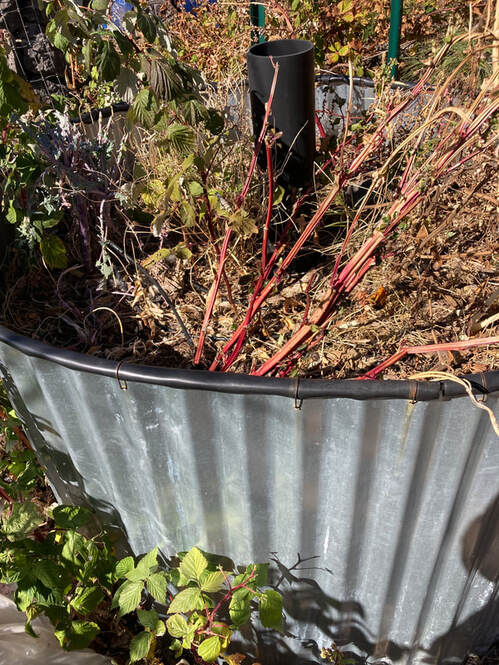 The pipe at the center of this garden bed is used for worm composting (vermiculture). After red wiggler worms are replenished each spring, fruit and veggie scraps can be deposited in the pipe to feed them. Holes have been drilled in the pipe below the soil level so the worms can move freely to access the food and travel around the container. Other tips from Rosemary:
Featured Plants
A garden offers the chance to play and experiment with a variety of plant species. The plants featured in Rosemary’s garden included the following:
Fruit Tree Resource: Trees of Antiquity in upstate New York is a source for well-adapted fruit trees for Flagstaff. OTHER PLANTS On our fieldtrip, we visited two other residential gardens. Below is a list of a few unique plants these gardeners are growing. From Patrick Grant:
From Greg Macallister:
Greg’s kale forest:
|
 RSS Feed
RSS Feed








